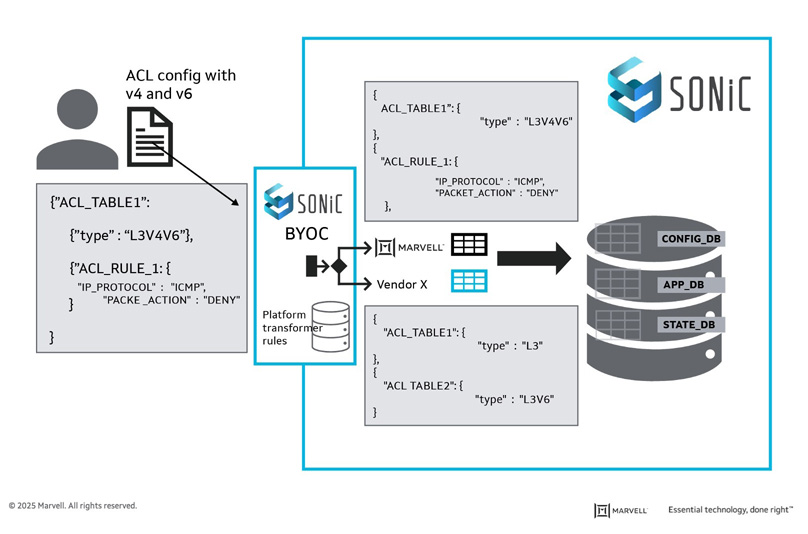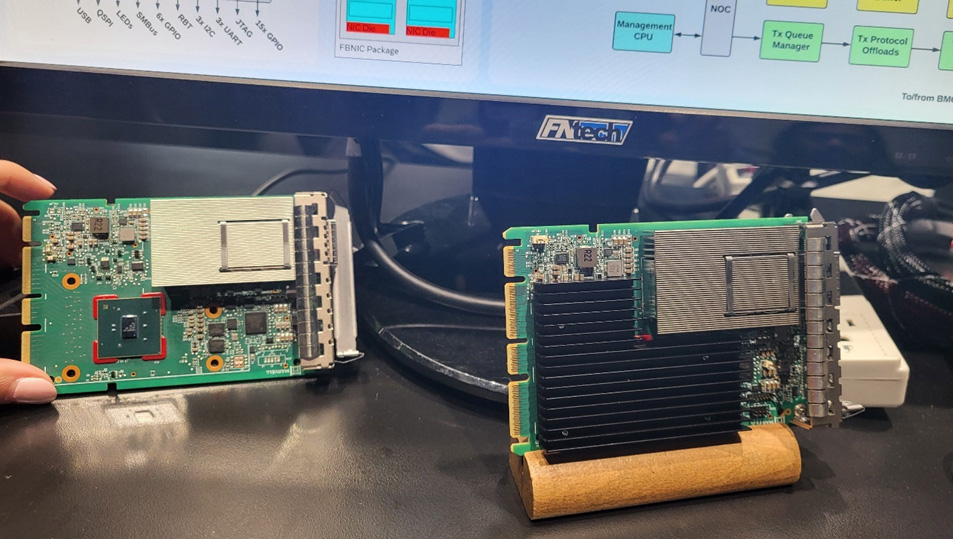

By Kishore Atreya, Senior Director of Cloud Platform Marketing, Marvell
Milliseconds matter.
It’s one of the fundamental laws of AI and cloud computing. Reducing the time required to run an individual workload frees up infrastructure to perform more work, which in turn creates an opportunity for cloud operators to potentially generate more revenue. Because they perform billions of simultaneous operations and operate on a 24/7/365 basis, time literally is money to cloud operators.
Marvell specifically designed the Marvell® Teralynx® 10 switch to optimize infrastructure for the intense performance demands of the cloud and AI era. Benchmark tests show that Teralynx 10 operates at a low and predictable 500 nanoseconds, a critical precursor for reducing time-to-completion.1 The 512-radix design of Teralynx 10 also means that large clusters or data centers with networks built around the device (versus 256-radix switch silicon) need up to 40% fewer switches, 33% fewer networking layers and 40% fewer connections to provide an equivalent level of aggregate bandwidth.2 Less equipment, of course, paves the way for lower costs, lower energy and better use of real estate.
Recently, we also teamed up with Keysight to provide deeper detail on another crucial feature of critical importance: auto-load balancing (ALB), or the ability of Teralynx 10 to even out traffic between ports based on current and anticipated loads. Like a highway system, spreading traffic more evenly across lanes in networks prevents congestion and reduces cumulative travel time. Without it, a crisis in one location becomes a problem for the entire system.
Better Load Balancing, Better Traffic Flow
To test our hypothesis of utilizing smarter load balancing for better load distribution, we created a scenario with Keysight AI Data Center Builder (KAI DC Builder) to measure port utilization and job completion time across different AI collective workloads. Built around a spine-leaf topology with four nodes, KAI DC Builder supports a range of collective algorithms, including all-to-all, all-reduce, all-gather, reduce-scatter, and gather. It facilitates the generation of RDMA traffic and operates using the RoCEv2 protocol. (In lay person’s terms, KAI DC Builder along with Keysight’s AresONE-M 800GE hardware platform enabled us to create a spectrum of test tracks.)
For generating AI traffic workloads, we used the Keysight Collective Communication Benchmark (KCCB) application. This application is installed as a container on the server, along with the Keysight provided supportive dockers..
In our tests, Keysight AresONE-M 800GE was connected to a Teralynx 10 Top-of-Rack switch via 16 400G OSFP ports. The ToR switch in turn was linked to a Teralynx 10 system configured as a leaf switch. We then measured port utilization and time-of-completion. All Teralynx 10 systems were loaded with SONiC.
By Ravindranath C Kanakarajan, Senior Principal Engineer, Switch BU
Marvell has been actively involved with SONiC since its beginning, with many SONiC switches powered by Marvell® ASICs at hyperscalers deployed worldwide. One of Marvell's goal has been to enhance SONiC to address common issues and optimize its performance for large-scale deployments.
The Challenge
Many hackathon projects have focused on improving the monitoring, troubleshooting, debuggability, and testing of SONiC. However, we believe one of the core roles of a network operating system (NOS) is to optimize the use of the hardware data plane (i.e., the NPUs and networking ASICs). As workloads become increasingly more demanding, it becomes crucial to maximize the efficiency of the data plane. Commercial black-box NOS are tailored to specific NPUs/ASICs to achieve optimal performance. SONiC, however, supports a diverse range of NPUs/ASICs, presenting a unique challenge.
We at Marvell have been contributing features to SONiC to ensure optimal use of the underlying networking ASIC resources. Over time, we’ve recognized the need to provide operators with flexibility in utilizing ASIC resources while reducing the platform-specific complexity gradually being introduced into SONiC’s core component, the Orchagent. This approach will help SONiC operators to maintain consistent device configurations even when using devices from different platform vendors.
BYOC
During the Hackathon, we developed a framework called “BYOC: Bring Your Own Configuration,” allowing networking ASIC vendors to expose their hardware capabilities in a file describing intent. A new agent transforms the user’s configuration into an optimal SONiC configuration based on the capabilities file. This approach allows ASIC vendors to ensure that user configurations are converted to optimal ASIC configurations. It also allows SONiC operators to fine-tune the hardware resources consumed based on the deployment needs. It further helps in optimally migrating configurations from vendor NOS to SONiC based on the SONiC platform’s capability.

By Michael Kanellos, Head of Influencer Relations, Marvell
What happened in semis and accelerated infrastructure in 2024? Here is the recap:
1. Custom Controls the Future
Until relatively recently, computing performance was achieved by increasing transistor density à la Moore’s Law. In the future, it will be achieved through innovative design, and many of those innovative design ideas will come to market first—and mostly— through custom processors tailored to use cases, software environments and performance goals thanks to a convergence of unusual and unstoppable forces1 that quietly began years ago.

FB NIC on display at OFC
By Kant Deshpande, Director, Product Management, Marvell
Disaggregation is the future
Disaggregation—the decoupling of hardware and software—is arguably the future of networking. Disaggregation lets customers select best-of-breed hardware and software, enabling rapid innovation by separating the hardware and software development paths.
Disaggregation started with server virtualization and is being adapted to storage and networking technology. In networking, disaggregation promises that any networking operating system (NOS) can be integrated with any switch silicon. Open source-standards like ONIE allow a networking switch to load and install any NOS during the boot process.
SONiC: the Linux of networking OS
Software for Open Networking in Cloud (SONiC) has been gaining momentum as the preferred open-source cloud-scale network operating system (NOS).
In fact, Gartner predicts that by 2025, 40% of organizations that operate large data center networks (greater than 200 switches) will run SONiC in a production environment.[i] According to Gartner, due to readily expanding customer interest and a commercial ecosystem, there is a strong possibility SONiC will become analogous to Linux for networking operating systems in next three to six years.
By Kishore Atreya, Director of Product Management, Marvell
Recently the Linux Foundation hosted its annual ONE Summit for open networking, edge projects and solutions. For the first time, this year’s event included a “mini-summit” for SONiC, an open source networking operating system targeted for data center applications that’s been widely adopted by cloud customers. A variety of industry members gave presentations, including Marvell’s very own Vijay Vyas Mohan, who presented on the topic of Extensible Platform Serdes Libraries. In addition, the SONiC mini-summit included a hackathon to motivate users and developers to innovate new ways to solve customer problems.
So, what could we hack?
At Marvell, we believe that SONiC has utility not only for the data center, but to enable solutions that span from edge to cloud. Because it’s a data center NOS, SONiC is not optimized for edge use cases. It requires an expensive bill of materials to run, including a powerful CPU, a minimum of 8 to 16GB DDR, and an SSD. In the data center environment, these HW resources contribute less to the BOM cost than do the optics and switch ASIC. However, for edge use cases with 1G to 10G interfaces, the cost of the processor complex, primarily driven by the NOS, can be a much more significant contributor to overall system cost. For edge disaggregation with SONiC to be viable, the hardware cost needs to be comparable to that of a typical OEM-based solution. Today, that’s not possible.